|
 We landed in Corsica at the end of March, 2002, planning to stay several weeks. We first came into Ajaccio, a large port on the west side of the island, located in a large natural bay (picture, below). We spent a couple of days in the town itself, wandering the streets, visiting the shops, trying the restaurants and enjoying the views. In the middle of the old town where we found our hotel, it was quite congested and noisy. But once you get a couple of blocks off the main road, it is a bit more civilized and quiet. Parking is a constant issue in the town, but luckily we had found a h We landed in Corsica at the end of March, 2002, planning to stay several weeks. We first came into Ajaccio, a large port on the west side of the island, located in a large natural bay (picture, below). We spent a couple of days in the town itself, wandering the streets, visiting the shops, trying the restaurants and enjoying the views. In the middle of the old town where we found our hotel, it was quite congested and noisy. But once you get a couple of blocks off the main road, it is a bit more civilized and quiet. Parking is a constant issue in the town, but luckily we had found a h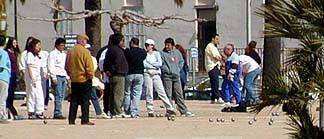 otel that provided secure enclosed parking for the motos. Ajaccio actually stretches for several miles along the coast of the bay and offers all the modern conveniences, including a BMW motorcycle dealer (more about this later). This is the birthplace of Napoleon Bonaparte, so you will find many tributes to him in the town (including many businesses bearing his name). The morning we left, we headed out of town to the north, passing the bouledrome where it appeared many of the locals were enjoying the sunny Easter morning. This was just one game, but the entire park area was solid with various games in progress. otel that provided secure enclosed parking for the motos. Ajaccio actually stretches for several miles along the coast of the bay and offers all the modern conveniences, including a BMW motorcycle dealer (more about this later). This is the birthplace of Napoleon Bonaparte, so you will find many tributes to him in the town (including many businesses bearing his name). The morning we left, we headed out of town to the north, passing the bouledrome where it appeared many of the locals were enjoying the sunny Easter morning. This was just one game, but the entire park area was solid with various games in progress.
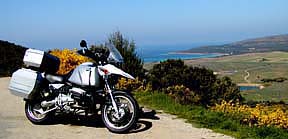 We headed out for our first experience of the Corsican roads by following the coast along the bay to the end of the bay where we could easily view the Iles Sanguinaires (Blood Islands, so-called because of their red rocks). A loop back toward town on a secondary road (but still in good condition) gave us a view of the isolated small cove of Minaccia (we found later through our travels that there are hundreds of these along the coast). Verna snapped the picture at right while Jim was off riding her bike to find out if he could determine what was causing a rather rhythmic thumping sound her bike was making. We continued along, enjoying the views of the green hills and spring flowers, until we came upon the city dump. So much for this scenic loop! We headed out for our first experience of the Corsican roads by following the coast along the bay to the end of the bay where we could easily view the Iles Sanguinaires (Blood Islands, so-called because of their red rocks). A loop back toward town on a secondary road (but still in good condition) gave us a view of the isolated small cove of Minaccia (we found later through our travels that there are hundreds of these along the coast). Verna snapped the picture at right while Jim was off riding her bike to find out if he could determine what was causing a rather rhythmic thumping sound her bike was making. We continued along, enjoying the views of the green hills and spring flowers, until we came upon the city dump. So much for this scenic loop!
 North of Ajaccio, the next large bay is the Gulf of Sagone. Here, we stopped overlooking the bay to take in the view and met up with 4 young men from Spain who couldn’t believe they found someone who spoke Spanish! We swapped cameras and took pictures of each other overlooking the beautiful bay. The weather was definitely improving as we were enjoying clear skies and sunshine, with only a few clouds in the distance. The road twists down to the gulf and follows the coast through the northern part of the gulf, with several small towns providing access to the beaches, restaurants, and boat rentals. North of Ajaccio, the next large bay is the Gulf of Sagone. Here, we stopped overlooking the bay to take in the view and met up with 4 young men from Spain who couldn’t believe they found someone who spoke Spanish! We swapped cameras and took pictures of each other overlooking the beautiful bay. The weather was definitely improving as we were enjoying clear skies and sunshine, with only a few clouds in the distance. The road twists down to the gulf and follows the coast through the northern part of the gulf, with several small towns providing access to the beaches, restaurants, and boat rentals.
At the north end of the gulf, the road turns inland and provides another 30 km of twisty-turny roads until we arrived at the small village of Piana. Man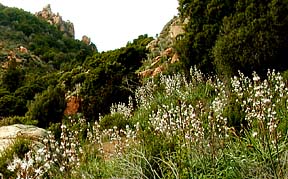 y of the hotels were not yet open for the season (or had dirt-track driveways on steep hills that we did not want to deal with if it rained), but we finally found a nice isolated hotel perched high on the hill with beautiful views of the coast. It was at this hotel that Jim noticed an oil drip on the final drive of Verna’s bike. We went for a late afternoon walk out along one of the rocky promontories for a more close-up view of the area. The area is great for hill walking and several marked trails are at your disposal in the area. The country is rugged, with heavy, shrubby growth so it is easier to stay on the beaten path (picture, right). Much of the island is covered with a dense growth of Maquis (various varieties including Rock Rose, Myrtle, and S y of the hotels were not yet open for the season (or had dirt-track driveways on steep hills that we did not want to deal with if it rained), but we finally found a nice isolated hotel perched high on the hill with beautiful views of the coast. It was at this hotel that Jim noticed an oil drip on the final drive of Verna’s bike. We went for a late afternoon walk out along one of the rocky promontories for a more close-up view of the area. The area is great for hill walking and several marked trails are at your disposal in the area. The country is rugged, with heavy, shrubby growth so it is easier to stay on the beaten path (picture, right). Much of the island is covered with a dense growth of Maquis (various varieties including Rock Rose, Myrtle, and S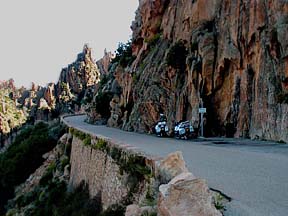 trawberry Tree - for those gardeners out there). Since it is so representative of the island, the resistance chose the name Maquis (later also to be used for the rebel group on Star Trek Voyager - for those Trekies out there). trawberry Tree - for those gardeners out there). Since it is so representative of the island, the resistance chose the name Maquis (later also to be used for the rebel group on Star Trek Voyager - for those Trekies out there).
The area just north of Piana is known as the Calanche and is a mass of jagged, red rock masses, steeply dropping to the sea. It is an area of exquisite beauty and has been named as a World Heritage Site by UNESCO. The strange rock formations have been formed by wind and erosion, and can be envisioned to look like any number of strange characters. The picture at left is Jim and the bikes where we stopped at one of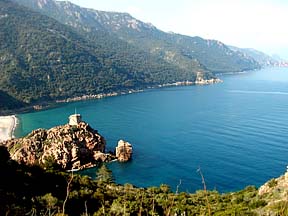 the several pullout areas along the road. As you can see, one doesn’t have a lot of room for mistakes here! the several pullout areas along the road. As you can see, one doesn’t have a lot of room for mistakes here!
Coming out of the Calanche, we found ourselves overlooking another picturesque bay, the Gulf of Porto. The town of Porto is major town in this area. Although we didn’t make a stop here, the Lonely Planet guide assures us that this seaside resort is packed in the summer and deserted in the winter (which can probably be said of most seaside resort areas on Corsica). On the north side of the gulf, the road rises again, giving panoramic views of the gulf (picture, right).
The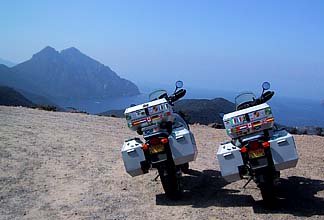 road rises from here and heads inland a bit, leading up to the Bocca de Palmarella (the pass is at 408 meters). Here we stopped for the expansive views over the sea and coast (pictured with the bikes at left). Although the road on the way up was under construction, it appeared they had just completed the construction on the other side, providing us with a smooth curvy road all the way down. road rises from here and heads inland a bit, leading up to the Bocca de Palmarella (the pass is at 408 meters). Here we stopped for the expansive views over the sea and coast (pictured with the bikes at left). Although the road on the way up was under construction, it appeared they had just completed the construction on the other side, providing us with a smooth curvy road all the way down.
Our next stop was Calvi, a small, idyllic town at the end of a spur of land in the Gulf of Calvi (below). The citadel sits at the end of this point, overlooking the harbor and town below. A local described this town as “tres joli” (very pretty) and we think we agree. There is a long row of restaurants along the waterfront with typical high tourist prices, but lovely outdoor seating at 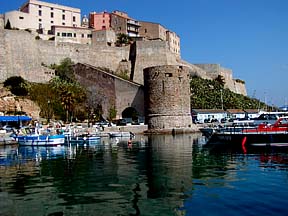 the water’s edge. We chose a smaller bistro a block up and enjoyed a wonderful lunch of eggplant gratin and onion tart. Yum! One thing we have found in France is that anyone with a few Euro isn’t going to go hungry. We also indulged in a brownie for dessert from a local bakery, but found it a bit dry (although very light and tasty) compared to our American brownies. We guess that some things just don’t translate well. the water’s edge. We chose a smaller bistro a block up and enjoyed a wonderful lunch of eggplant gratin and onion tart. Yum! One thing we have found in France is that anyone with a few Euro isn’t going to go hungry. We also indulged in a brownie for dessert from a local bakery, but found it a bit dry (although very light and tasty) compared to our American brownies. We guess that some things just don’t translate well.
On the way north toward I’lle Rouse, we spotted this fantastic old sailing ship (below), just of the coast and had to stop for a picture. The nearby cove looked quite inviting and appeared to be home to a Club Med (which would make it a bit less appealing, at least from our perspective).
 I’lle Rousse (which no longer has an island since it was connected to the town by fill), is just a short drive north of Calvi. Although the ferry boats dock here, the town retains a small-town charm and is not too touristy. We found the Hotel Splendid to be our comfortable home for the night. This hotel served as a hospital from 1939 to 1944 during the war. Although the building is old (1929), it has had constant renovation to keep it up-to-date. Luckily for us, the owners spoke excellent English which we put to good use. It was here, in the hotel parking lot, that the seal which retains the oil in the final drive on Verna’s bike decided to fail. Between the time we stopped at the hotel and got a room and came out of the hotel (about 5 minutes) about 1/8th of the oil in the final drive was on the ground. I’lle Rousse (which no longer has an island since it was connected to the town by fill), is just a short drive north of Calvi. Although the ferry boats dock here, the town retains a small-town charm and is not too touristy. We found the Hotel Splendid to be our comfortable home for the night. This hotel served as a hospital from 1939 to 1944 during the war. Although the building is old (1929), it has had constant renovation to keep it up-to-date. Luckily for us, the owners spoke excellent English which we put to good use. It was here, in the hotel parking lot, that the seal which retains the oil in the final drive on Verna’s bike decided to fail. Between the time we stopped at the hotel and got a room and came out of the hotel (about 5 minutes) about 1/8th of the oil in the final drive was on the ground.
So, our challenge at this point was to find a BMW motorcycle dealer that could repair the seal. It turned out that there is a dealer in Ajaccio. This made us very happy because we thought we would have to transport the bike to France or Italy to get the repair done. Thanks to the hotel owner we were able to deal with the driver who transported Verna’s bike to Ajaccio.
After a couple of days, we were back on the road again, heading north right up the center of the island. For more information about the problem with the bike, see the 2002 page under the Equipment Report Card page in The Bikes section. As we started gaining elevation, it was getting quite nippy, especially as we started seeing the fresh
 |
snow along side the road. Luckily the roads were clear, although wet from the runoff. We stopped in a little town Bocognano to take a picture of the majestic peaks in all their snowy glory, before the clouds closed in on us. The town was at 2500 feet, the snow started at 3200 feet and we went over the pass at 3600 feet (1000 meters). This is truly some rugged, beautiful country. Most of the road south of Corte is curvy and great for the motorbikes. The scenery is wonderful, the road is in good condition, and at least at this time of year, the traffic is minimal. However, the Ricky-roadracers are still out there in their cars, passing where it is not safe and cutting corners on the curves, so keep your eyes open!
Our next stop was in Bastia on the northeast coast for the night. This is the most imp ortant commercial center on the island and has the traffic to prove it! Once you get into town, it is constant gridlock. Thankfully we found a hotel without having to drive too far, then went out on foot to enjoy the town. Bastia has lots of shops and restaurants as well as cars, and negotiating the town on foot was definitely easier. We walked up to the where the old fortress was, but didn’t find much of interest other than a great view of the city (picture at right). In the center of town there is a huge paved park where everyone seems to meet, chat, and let the kids run and play. The many outdoor cafes allow one to sit and enjoy all the activity at your leisure. ortant commercial center on the island and has the traffic to prove it! Once you get into town, it is constant gridlock. Thankfully we found a hotel without having to drive too far, then went out on foot to enjoy the town. Bastia has lots of shops and restaurants as well as cars, and negotiating the town on foot was definitely easier. We walked up to the where the old fortress was, but didn’t find much of interest other than a great view of the city (picture at right). In the center of town there is a huge paved park where everyone seems to meet, chat, and let the kids run and play. The many outdoor cafes allow one to sit and enjoy all the activity at your leisure.
We then headed for Cap Corse, the long peninsula on the northeast portion of the island. We went up the eastern side, along a curvy, but mostly level road as it followed the coastline. This side of the island is much more gentle and less dramatic than the western side and made for an easy-paced ride north, passing the many bicyclists out on their Saturday ride. There are few towns along this part of the road, one of them is the town of Saint Severa shown at left; just a tiny quiet harbor village where another road cuts across the cap. then headed for Cap Corse, the long peninsula on the northeast portion of the island. We went up the eastern side, along a curvy, but mostly level road as it followed the coastline. This side of the island is much more gentle and less dramatic than the western side and made for an easy-paced ride north, passing the many bicyclists out on their Saturday ride. There are few towns along this part of the road, one of them is the town of Saint Severa shown at left; just a tiny quiet harbor village where another road cuts across the cap.
The main road generally follow along the coast until you get to the very northern point of the island. At that point it cuts across the cap, although there a couple of local roads that will take you all the way to the northernmost villages. We made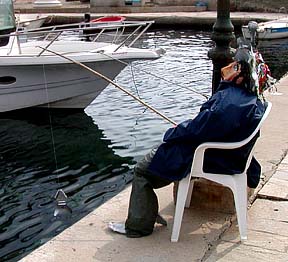 a loop by riding north on one road and back south on the other. We visited the village of Barcaggio on the far northern coast. Barcaggio is a quiet little town with a small harbor where we found this local fisherman (picture, right). We thought he was cute, though very quiet. We’re not sure just how long that fish has been hanging on the line. a loop by riding north on one road and back south on the other. We visited the village of Barcaggio on the far northern coast. Barcaggio is a quiet little town with a small harbor where we found this local fisherman (picture, right). We thought he was cute, though very quiet. We’re not sure just how long that fish has been hanging on the line.
Below, Jim and the bikes by the harbor marks our northernmost point on the island. Suddenly, the quiet of the town was disturbed with the raucous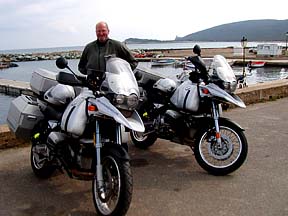 honking of the butcher’s van coming to town. The dogs barked their welcoming glee and suddenly several women appeared in the square from seemingly nowhere. It was Saturday morning and time to do the shopping... honking of the butcher’s van coming to town. The dogs barked their welcoming glee and suddenly several women appeared in the square from seemingly nowhere. It was Saturday morning and time to do the shopping...
Heading back to the main road, then south along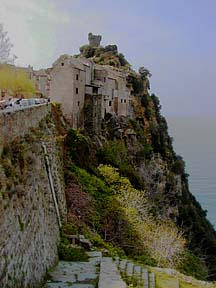 the western coast, the mountainous area is sparsely populated. Little villages, when you see them, appear to be literally clinging to the sides of the mountains (right). We finally stopped at a restaurant along the road (there weren’t many to choose from!) for our lunch. This restaurant was named Le Chat Qui Peche (The Cat Who Fishes). Well, we’re not sure how true that was, but Jim the western coast, the mountainous area is sparsely populated. Little villages, when you see them, appear to be literally clinging to the sides of the mountains (right). We finally stopped at a restaurant along the road (there weren’t many to choose from!) for our lunch. This restaurant was named Le Chat Qui Peche (The Cat Who Fishes). Well, we’re not sure how true that was, but Jim  enjoyed the best bowl of mussels he has ever eaten. They were very fresh and lightly cooked, resulting in mussels that were extremely tender and tasty. Although we spoke virtually no French, the owners were extremely welcoming and cordial to us. enjoyed the best bowl of mussels he has ever eaten. They were very fresh and lightly cooked, resulting in mussels that were extremely tender and tasty. Although we spoke virtually no French, the owners were extremely welcoming and cordial to us.
Further along the coast, near Nonza, were a stretch of black-sand beaches (left). They were quite striking in appearance and it seems that the locals (probably kids) enjoy writing names and symbols in the sand using white rocks which stand out against the dark sand.
After completing the tour of the cap, we headed inland and back over to the east coast. The road along the coast from Bastia to Aleria is mostly flat and straight, with few view of the sea. After all the twisty-turny roads earlier in the day, this was a good place to make some time before finding a hotel for the night which turned out to be a problem! There are many campground and summertime tourist villages along the sea, but at this time of year it was a bit cool to camp and the tourist camps weren’t open yet. We were unsuccessful in finding anything until Aleria. There we found a fairly new hotel in excellent condition, with a garage in the back where they let us park the bikes. The owner has an African Twin and struck up a conversation with Jim in Spanish as it was their only language in c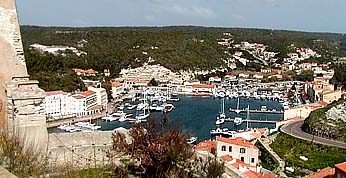 ommon. Thank goodness we can now say we speak (in a limited way) another language! ommon. Thank goodness we can now say we speak (in a limited way) another language!
The drive south from Aleria to Bonafacio is straight with few changes in altitude - somewhat boring after the spectacular west coast and central mountains. However, given the weather (it started to rain just as we got on the bikes) we decided it was the best route for the conditions. Had the weather been nice, we would have probably opted to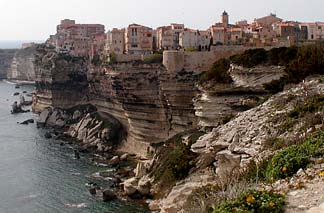 head inla nd a bit and taken a more interesting route through the mountains. We drove through the port of Porto-Vecchio on the way down, but found nothing of interest for which to stop. We found Bonafacio to be a small town snuggled in the cove of a long inlet (picture, above). Not a lot of choice for hotels, especially with parking. We settled for one in the harbor area but later fo head inla nd a bit and taken a more interesting route through the mountains. We drove through the port of Porto-Vecchio on the way down, but found nothing of interest for which to stop. We found Bonafacio to be a small town snuggled in the cove of a long inlet (picture, above). Not a lot of choice for hotels, especially with parking. We settled for one in the harbor area but later fo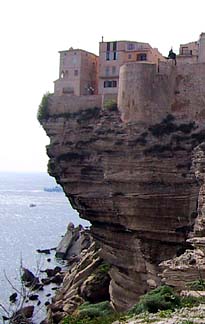 und we should have opted for the nicer one to the west of the old town on the hill. und we should have opted for the nicer one to the west of the old town on the hill.
The old town sits on top of the hill (left) and can be reached by climbing the stairs from the port or by paying 5 Euro and riding the little tourist train to the top (guess which we did!). Once at the top, you can wander at your leisure through the old town where you will find lots of tourist shops and restaurants. There is also the old fortress and a path that will take you along the cliffs. The picture at right shows just how much these folks like living on the edge. The building to the far left is probably the newest one there - it seems strange to us that people would continue to build that close to the edge.
From the old town, you can get a f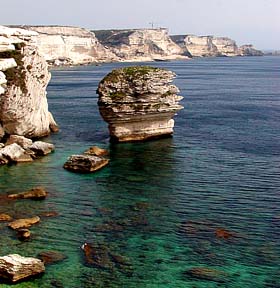 antastic view of the coastline looking east. The sandstone cliffs have been eroded away by wind and water, forming dramatic shapes (left). Of course, the clear blue water just adds to the picturesque scene. antastic view of the coastline looking east. The sandstone cliffs have been eroded away by wind and water, forming dramatic shapes (left). Of course, the clear blue water just adds to the picturesque scene.
Overall, we leave Corsica with a very positive view of the island. It has a dramatic variation of geologic formations, from quiet sandy beaches to rocky cliffs to snowcapped craggy mountains. That’s quite a lot for such a small area. Of course, for the motorcyclist, the roads are wonderful! You can get as much or little of the twisty-turnies as you want. In general we found decent accommodations, people that were very friendly and helpful, and the prices are not much different than mainland France. About a week and a half would be sufficient time to fully explore the island at your leisure. If you drive, beware that the road surfaces vary greatly from new smooth macadam to dirt and rocks - all on the same road and lots of variations in between. Also beware of the other drivers. While we felt that the drivers here are much more safety conscious than those in Spain we were amazed at the number who are willing to risk injury or death to themselves, their passengers and other road users by driving in the oncoming traffic lane when going around corners which offer them no vision of the oncoming traffic.
 |
And as we sail away toward our next adventure in Sardinia, we bid Corsica a fond adieu... |

 We landed in Corsica at the end of March, 2002, planning to stay several weeks. We first came into Ajaccio, a large port on the west side of the island, located in a large natural bay (picture, below). We spent a couple of days in the town itself, wandering the streets, visiting the shops, trying the restaurants and enjoying the views. In the middle of the old town where we found our hotel, it was quite congested and noisy. But once you get a couple of blocks off the main road, it is a bit more civilized and quiet. Parking is a constant issue in the town, but luckily we had found a h
We landed in Corsica at the end of March, 2002, planning to stay several weeks. We first came into Ajaccio, a large port on the west side of the island, located in a large natural bay (picture, below). We spent a couple of days in the town itself, wandering the streets, visiting the shops, trying the restaurants and enjoying the views. In the middle of the old town where we found our hotel, it was quite congested and noisy. But once you get a couple of blocks off the main road, it is a bit more civilized and quiet. Parking is a constant issue in the town, but luckily we had found a h otel that provided secure enclosed parking for the motos. Ajaccio actually stretches for several miles along the coast of the bay and offers all the modern conveniences, including a BMW motorcycle dealer (more about this later). This is the birthplace of Napoleon Bonaparte, so you will find many tributes to him in the town (including many businesses bearing his name). The morning we left, we headed out of town to the north, passing the bouledrome where it appeared many of the locals were enjoying the sunny Easter morning. This was just one game, but the entire park area was solid with various games in progress.
otel that provided secure enclosed parking for the motos. Ajaccio actually stretches for several miles along the coast of the bay and offers all the modern conveniences, including a BMW motorcycle dealer (more about this later). This is the birthplace of Napoleon Bonaparte, so you will find many tributes to him in the town (including many businesses bearing his name). The morning we left, we headed out of town to the north, passing the bouledrome where it appeared many of the locals were enjoying the sunny Easter morning. This was just one game, but the entire park area was solid with various games in progress.  We headed out for our first experience of the Corsican roads by following the coast along the bay to the end of the bay where we could easily view the Iles Sanguinaires (Blood Islands, so-called because of their red rocks). A loop back toward town on a secondary road (but still in good condition) gave us a view of the isolated small cove of Minaccia (we found later through our travels that there are hundreds of these along the coast). Verna snapped the picture at right while Jim was off riding her bike to find out if he could determine what was causing a rather rhythmic thumping sound her bike was making. We continued along, enjoying the views of the green hills and spring flowers, until we came upon the city dump. So much for this scenic loop!
We headed out for our first experience of the Corsican roads by following the coast along the bay to the end of the bay where we could easily view the Iles Sanguinaires (Blood Islands, so-called because of their red rocks). A loop back toward town on a secondary road (but still in good condition) gave us a view of the isolated small cove of Minaccia (we found later through our travels that there are hundreds of these along the coast). Verna snapped the picture at right while Jim was off riding her bike to find out if he could determine what was causing a rather rhythmic thumping sound her bike was making. We continued along, enjoying the views of the green hills and spring flowers, until we came upon the city dump. So much for this scenic loop! North of Ajaccio, the next large bay is the Gulf of Sagone. Here, we stopped overlooking the bay to take in the view and met up with 4 young men from Spain who couldn’t believe they found someone who spoke Spanish! We swapped cameras and took pictures of each other overlooking the beautiful bay. The weather was definitely improving as we were enjoying clear skies and sunshine, with only a few clouds in the distance. The road twists down to the gulf and follows the coast through the northern part of the gulf, with several small towns providing access to the beaches, restaurants, and boat rentals.
North of Ajaccio, the next large bay is the Gulf of Sagone. Here, we stopped overlooking the bay to take in the view and met up with 4 young men from Spain who couldn’t believe they found someone who spoke Spanish! We swapped cameras and took pictures of each other overlooking the beautiful bay. The weather was definitely improving as we were enjoying clear skies and sunshine, with only a few clouds in the distance. The road twists down to the gulf and follows the coast through the northern part of the gulf, with several small towns providing access to the beaches, restaurants, and boat rentals. y of the hotels were not yet open for the season (or had dirt-track driveways on steep hills that we did not want to deal with if it rained), but we finally found a nice isolated hotel perched high on the hill with beautiful views of the coast. It was at this hotel that Jim noticed an oil drip on the final drive of Verna’s bike. We went for a late afternoon walk out along one of the rocky promontories for a more close-up view of the area. The area is great for hill walking and several marked trails are at your disposal in the area. The country is rugged, with heavy, shrubby growth so it is easier to stay on the beaten path (picture, right). Much of the island is covered with a dense growth of Maquis (various varieties including Rock Rose, Myrtle, and S
y of the hotels were not yet open for the season (or had dirt-track driveways on steep hills that we did not want to deal with if it rained), but we finally found a nice isolated hotel perched high on the hill with beautiful views of the coast. It was at this hotel that Jim noticed an oil drip on the final drive of Verna’s bike. We went for a late afternoon walk out along one of the rocky promontories for a more close-up view of the area. The area is great for hill walking and several marked trails are at your disposal in the area. The country is rugged, with heavy, shrubby growth so it is easier to stay on the beaten path (picture, right). Much of the island is covered with a dense growth of Maquis (various varieties including Rock Rose, Myrtle, and S trawberry Tree - for those gardeners out there). Since it is so representative of the island, the resistance chose the name Maquis (later also to be used for the rebel group on Star Trek Voyager - for those Trekies out there).
trawberry Tree - for those gardeners out there). Since it is so representative of the island, the resistance chose the name Maquis (later also to be used for the rebel group on Star Trek Voyager - for those Trekies out there). the several pullout areas along the road. As you can see, one doesn’t have a lot of room for mistakes here!
the several pullout areas along the road. As you can see, one doesn’t have a lot of room for mistakes here! road rises from here and heads inland a bit, leading up to the Bocca de Palmarella (the pass is at 408 meters). Here we stopped for the expansive views over the sea and coast (pictured with the bikes at left). Although the road on the way up was under construction, it appeared they had just completed the construction on the other side, providing us with a smooth curvy road all the way down.
road rises from here and heads inland a bit, leading up to the Bocca de Palmarella (the pass is at 408 meters). Here we stopped for the expansive views over the sea and coast (pictured with the bikes at left). Although the road on the way up was under construction, it appeared they had just completed the construction on the other side, providing us with a smooth curvy road all the way down. the water’s edge. We chose a smaller bistro a block up and enjoyed a wonderful lunch of eggplant gratin and onion tart. Yum! One thing we have found in France is that anyone with a few Euro isn’t going to go hungry. We also indulged in a brownie for dessert from a local bakery, but found it a bit dry (although very light and tasty) compared to our American brownies. We guess that some things just don’t translate well.
the water’s edge. We chose a smaller bistro a block up and enjoyed a wonderful lunch of eggplant gratin and onion tart. Yum! One thing we have found in France is that anyone with a few Euro isn’t going to go hungry. We also indulged in a brownie for dessert from a local bakery, but found it a bit dry (although very light and tasty) compared to our American brownies. We guess that some things just don’t translate well. I’lle Rousse (which no longer has an island since it was connected to the town by fill), is just a short drive north of Calvi. Although the ferry boats dock here, the town retains a small-town charm and is not too touristy. We found the Hotel Splendid to be our comfortable home for the night. This hotel served as a hospital from 1939 to 1944 during the war. Although the building is old (1929), it has had constant renovation to keep it up-to-date. Luckily for us, the owners spoke excellent English which we put to good use. It was here, in the hotel parking lot, that the seal which retains the oil in the final drive on Verna’s bike decided to fail. Between the time we stopped at the hotel and got a room and came out of the hotel (about 5 minutes) about 1/8th of the oil in the final drive was on the ground.
I’lle Rousse (which no longer has an island since it was connected to the town by fill), is just a short drive north of Calvi. Although the ferry boats dock here, the town retains a small-town charm and is not too touristy. We found the Hotel Splendid to be our comfortable home for the night. This hotel served as a hospital from 1939 to 1944 during the war. Although the building is old (1929), it has had constant renovation to keep it up-to-date. Luckily for us, the owners spoke excellent English which we put to good use. It was here, in the hotel parking lot, that the seal which retains the oil in the final drive on Verna’s bike decided to fail. Between the time we stopped at the hotel and got a room and came out of the hotel (about 5 minutes) about 1/8th of the oil in the final drive was on the ground.
 ortant commercial center on the island and has the traffic to prove it! Once you get into town, it is constant gridlock. Thankfully we found a hotel without having to drive too far, then went out on foot to enjoy the town. Bastia has lots of shops and restaurants as well as cars, and negotiating the town on foot was definitely easier. We walked up to the where the old fortress was, but didn’t find much of interest other than a great view of the city (picture at right). In the center of town there is a huge paved park where everyone seems to meet, chat, and let the kids run and play. The many outdoor cafes allow one to sit and enjoy all the activity at your leisure.
ortant commercial center on the island and has the traffic to prove it! Once you get into town, it is constant gridlock. Thankfully we found a hotel without having to drive too far, then went out on foot to enjoy the town. Bastia has lots of shops and restaurants as well as cars, and negotiating the town on foot was definitely easier. We walked up to the where the old fortress was, but didn’t find much of interest other than a great view of the city (picture at right). In the center of town there is a huge paved park where everyone seems to meet, chat, and let the kids run and play. The many outdoor cafes allow one to sit and enjoy all the activity at your leisure.  then headed for
then headed for  a loop by riding north on one road and back south on the other. We visited the village of Barcaggio on the far northern coast. Barcaggio is a quiet little town with a small harbor where we found this local fisherman (picture, right). We thought he was cute, though very quiet. We’re not sure just how long that fish has been hanging on the line.
a loop by riding north on one road and back south on the other. We visited the village of Barcaggio on the far northern coast. Barcaggio is a quiet little town with a small harbor where we found this local fisherman (picture, right). We thought he was cute, though very quiet. We’re not sure just how long that fish has been hanging on the line.  honking of the butcher’s van coming to town. The dogs barked their welcoming glee and suddenly several women appeared in the square from seemingly nowhere. It was Saturday morning and time to do the shopping...
honking of the butcher’s van coming to town. The dogs barked their welcoming glee and suddenly several women appeared in the square from seemingly nowhere. It was Saturday morning and time to do the shopping... the western coast, the mountainous area is sparsely populated. Little villages, when you see them, appear to be literally clinging to the sides of the mountains (right). We finally stopped at a restaurant along the road (there weren’t many to choose from!) for our lunch. This restaurant was named Le Chat Qui Peche (The Cat Who Fishes). Well, we’re not sure how true that was, but Jim
the western coast, the mountainous area is sparsely populated. Little villages, when you see them, appear to be literally clinging to the sides of the mountains (right). We finally stopped at a restaurant along the road (there weren’t many to choose from!) for our lunch. This restaurant was named Le Chat Qui Peche (The Cat Who Fishes). Well, we’re not sure how true that was, but Jim  enjoyed the best bowl of mussels he has ever eaten. They were very fresh and lightly cooked, resulting in mussels that were extremely tender and tasty. Although we spoke virtually no French, the owners were extremely welcoming and cordial to us.
enjoyed the best bowl of mussels he has ever eaten. They were very fresh and lightly cooked, resulting in mussels that were extremely tender and tasty. Although we spoke virtually no French, the owners were extremely welcoming and cordial to us.  ommon. Thank goodness we can now say we speak (in a limited way) another language!
ommon. Thank goodness we can now say we speak (in a limited way) another language! head inla nd a bit and taken a more interesting route through the mountains. We drove through the port of Porto-Vecchio on the way down, but found nothing of interest for which to stop. We found Bonafacio to be a small town snuggled in the cove of a long inlet (picture, above). Not a lot of choice for hotels, especially with parking. We settled for one in the harbor area but later fo
head inla nd a bit and taken a more interesting route through the mountains. We drove through the port of Porto-Vecchio on the way down, but found nothing of interest for which to stop. We found Bonafacio to be a small town snuggled in the cove of a long inlet (picture, above). Not a lot of choice for hotels, especially with parking. We settled for one in the harbor area but later fo und we should have opted for the nicer one to the west of the old town on the hill.
und we should have opted for the nicer one to the west of the old town on the hill.  antastic view of the coastline looking east. The sandstone cliffs have been eroded away by wind and water, forming dramatic shapes (left). Of course, the clear blue water just adds to the picturesque scene.
antastic view of the coastline looking east. The sandstone cliffs have been eroded away by wind and water, forming dramatic shapes (left). Of course, the clear blue water just adds to the picturesque scene.